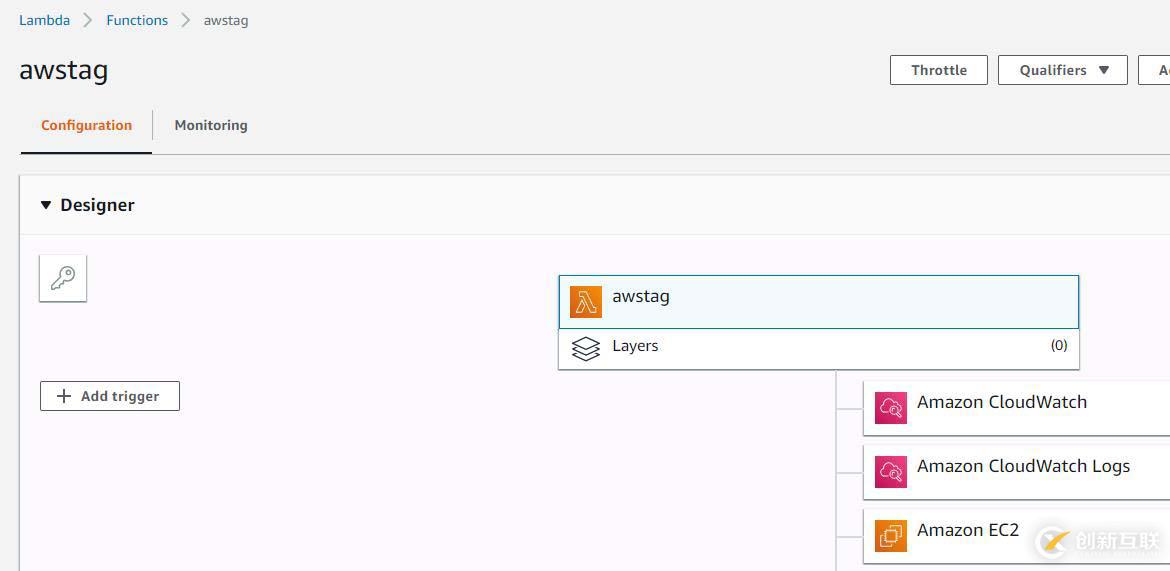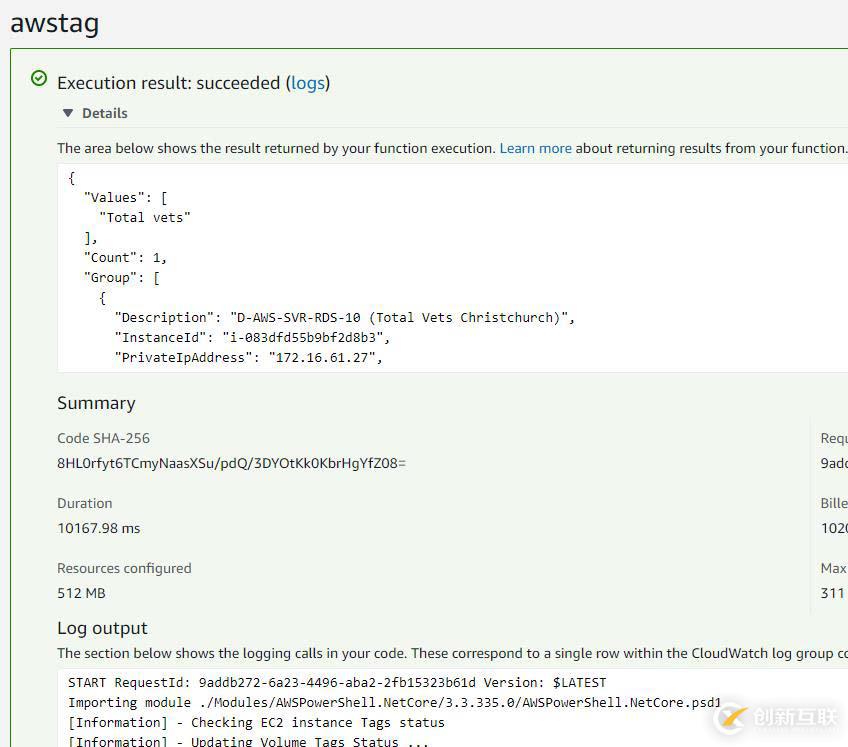AWSLambda自動化和PowerShell-創新互聯
這兩天我都在看如何使用Lambda和Python,但是平常更習慣使用PowerShell來管理各種系統。試試看如何在Lambda里面使用PowerShell吧。

首先在本地計算機上需要安裝下面三個模塊。
安裝PowerShell Core
https://github.com/powershell/powershell
安裝 the .NET Core Software Development Kit (SDK)
https://www.microsoft.com/net/download
安裝 AWSLambdaPSCore module
Install-Module AWSLambdaPSCore -Scope CurrentUser
安裝好了,在Powershell6的控制臺 里面執行
New-AWSPowerShellLambda -ScriptName awstag -Template basic
他會自動根據basic的模板創建一個目錄,里面用一個空白的ps文件,和一個readme文件。這個空白的ps文件自動加載了powershellcore的模塊,如果我們需要添加其他的模塊,需要在這里修改。下面是我的一個測試腳本。這個腳本主要的功能是檢查tag,確保EC2,Volume和Snapshot都有對應的tag,因為每個月我需要通過tag來顯示不同診所的賬單。另外如果snapshot如果超過60天,順便也自動給我刪除了。
# PowerShell script file to be executed as a AWS Lambda function.
#
# When executing in Lambda the following variables will be predefined.
# $LambdaInput - A PSObject that contains the Lambda function input data.
# $LambdaContext - An Amazon.Lambda.Core.ILambdaContext object that contains information about the currently running Lambda environment.
#
# The last item in the PowerShell pipeline will be returned as the result of the Lambda function.
#
# To include PowerShell modules with your Lambda function, like the AWSPowerShell.NetCore module, add a "#Requires" statement
# indicating the module and version.
#Requires -Modules @{ModuleName='AWSPowerShell.NetCore';ModuleVersion='3.3.335.0'}
# Uncomment to send the input event to CloudWatch Logs
# Write-Host (ConvertTo-Json -InputObject $LambdaInput -Compress -Depth 5)
Write-Host "Checking EC2 instance Tags status" -ForegroundColor Yellow
$all=Get-EC2Instance | select -expand instances
$return=$all | Where-Object {$_.tag.key -notcontains "Clinic"}
if($return -ne $null){
$username = "test@abc.com"
$password = "Passwordtest" | ConvertTo-SecureString -asPlainText -Force
$credential = New-Object System.Management.Automation.PSCredential($username,$password)
$id=$return.InstanceId
Send-MailMessage -From test@abc.com -to test@abc.com -SmtpServer smtp.office365.com -Port 587 -UseSsl -Subject "EC2 instance Tag" -body "$id" -Credential $credential
exit
}
# confirm EC2 instances were tagged
$result=@()
foreach($item in $all){
$Name=$item.tag | Where-Object {$_.Key -eq 'Name'} | select -ExpandProperty value
$clinic=$item.tag | Where-Object {$_.Key -eq 'clinic'} | select -ExpandProperty value
$item | add-member -NotePropertyName Description -NotePropertyValue $name
$item | add-member -NotePropertyName Clinic -NotePropertyValue $clinic
$item = $item | select *
$result+=$item
}
$result | select Description, InstanceId, privateIpaddress, Clinic | Group-Object Clinic
write-host "Updating Volume Tags Status ... " -ForegroundColor Yellow
#Tag all volumes based on their attached EC2 Clinic Tag
$allvol=Get-EC2Volume | Where-Object {$_.tag.key -notcontains "Clinic"}
foreach($item in $result){
foreach($item2 in $allvol){
if ($item2.attachments.instanceid -eq $item.InstanceId){
$value=$item.Clinic
New-EC2Tag -Resource $item2.VolumeId -Tag @{Key="Clinic";value=$value}
}
}
}
Write-Host "Updating Snapshot Tags Status..." -ForegroundColor Yellow
#Tag all snapshots based on the volume Tag
$allvol=Get-EC2Volume
$filter= New-Object Amazon.EC2.Model.Filter -Property @{Name = "owner-id"; Values ='386115804199' }
$snapshots=Get-EC2Snapshot -Filter $filter
$snapshots1= $snapshots | ? {$_.Tag.key -notcontains "Clinic"}
foreach($i in $snapshots1){
$volid=$i.VolumeId
foreach($j in $allvol){
if($volid -eq $j.Volumeid){
$value=$j.tag | Where-Object {$_.key -eq 'Clinic'} | select -ExpandProperty value
$name=$j.Tag | Where-Object {$_.key -eq "Name"} | select -ExpandProperty value
$snapid=$i.snapshotid
write-host "--$snapid--"
New-EC2Tag -Resource $snapid -Tag @{Key="Clinic";value=$value}
New-EC2Tag -Resource $snapid -Tag @{Key="Name";value=$name}
}
}
}
write-host "Deleting Snapshots older than over 60 days !" -ForegroundColor Yellow
$date=(get-date).AddDays(-40)
foreach($snapshot in $snapshots){
$id=$snapshot.snapshotid
if($snapshot.starttime -lt $date){
$snapshot
Remove-EC2Snapshot -SnapshotId $id -Confirm:$false
}
}接下來在Powershell6 的控制臺執行,他會自動綁定iam的role,壓縮相關的模塊和執行腳本,然后上傳到Lambda的控制臺。這里的iam role我是隨便寫的,允許訪問ec2和 cloudwatch log。
Publish-AWSPowerShellLambda -ScriptPath .\awstag.ps1 -name awstag -iamrole 'ec2fullaccess' -Region ap-southeast-2
等個1分鐘,登錄aws 就可以看見上傳的函數了。

代碼這一塊不像Python能直接看見,直接告訴你太大 沒法顯示 但是我可以直接調用

測試一下試試,顯示成功

去對應的cloudwatch 看看

Done!
另外有需要云服務器可以了解下創新互聯cdcxhl.cn,海內外云服務器15元起步,三天無理由+7*72小時售后在線,公司持有idc許可證,提供“云服務器、裸金屬服務器、高防服務器、香港服務器、美國服務器、虛擬主機、免備案服務器”等云主機租用服務以及企業上云的綜合解決方案,具有“安全穩定、簡單易用、服務可用性高、性價比高”等特點與優勢,專為企業上云打造定制,能夠滿足用戶豐富、多元化的應用場景需求。
當前題目:AWSLambda自動化和PowerShell-創新互聯
瀏覽地址:http://vcdvsql.cn/article38/dsdpsp.html
成都網站建設公司_創新互聯,為您提供定制開發、搜索引擎優化、網頁設計公司、微信小程序、網站建設、做網站
聲明:本網站發布的內容(圖片、視頻和文字)以用戶投稿、用戶轉載內容為主,如果涉及侵權請盡快告知,我們將會在第一時間刪除。文章觀點不代表本網站立場,如需處理請聯系客服。電話:028-86922220;郵箱:631063699@qq.com。內容未經允許不得轉載,或轉載時需注明來源: 創新互聯

- 手機網站建設的好處和發展前景 2022-11-23
- 沒有彈窗的手機網站建設需要注意什么? 2016-11-01
- 手機網站建設有注意什么問題 2022-05-30
- 手機端網站設計的必要性 2016-08-02
- 做一個手機網站需要多少費用? 2016-08-13
- 手機網站建設的過程中要注意哪些問題? 2016-10-30
- 手機網站建設提出幾個觀點 2023-02-25
- 制作手機網站有什么技巧? 2014-02-20
- 手機網站制作和電腦端網站制作有哪些不一樣 2014-04-10
- 企業建站選擇Pc網站建設還是手機端網站制作?它們有什么區別? 2016-09-21
- 對于企業建設手機網站的重要性分析 2016-08-13
- 談手機app的推廣方式 2016-11-05